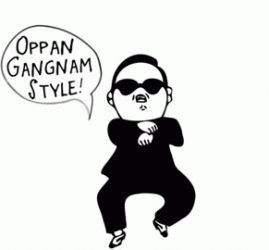Video Analysis about PSY- ‘I LUV IT’
PSY is one of Korean K-pop start, his songs make people feel chill, relax even crazy. Expect the most famous song Gangnam Style, he still has lot of famous music videos. As a result, according to another PSY’s video song “I LUV IT”, it is a choreographic and concept-based video. The genre of this music video is lively and relax, the dance and lyrics combined very balance as well. In this music video “I LUV IT”, PSY uses “LUV IT” as a main concept to tell his audiences: doing things as you love it, you enjoy it and you deserve it.
First, doing things as you love it. The main lyrics in this music is “I LUV IT”. In the MV, when PSY sings “I LUV IT” he probably shows his dancing as well. It is a very simple dance with both legs and arms shaking. As we know, this music including his album 4X2=8, and have surged over 53 million and 63 million views on his official YouTube channel(New straits times 2017). This number also improves that lots of people believe his concept: “I LUV IT”. And in this MV, the dance part with lyric “I LUV IT”, there has a lot of different backgrounds such as classroom, guitar place and in front of home. All those places are very colorful. So I believe PSY wants to tell us, whatever where you are, you love the place you stay at and doing things you love it.
Second, doing things as you enjoy it. Except different places in the MV I mentioned last part, PSY also wants to via this music video to tell us that doing things as the way you real enjoy it. For instance, in the MV around 48 seconds, PSY said: “No need for chopsticks, bring your fork and eat it up.” At that time, PSY sited and he eat a piece of watermelon, he did not use any tableware even the fork, just used his hands. As we know, Korean people use chopsticks for their solid food (Dr, Deson). And the chopsticks in this music video mean clean and respectful even get rid of tying. PSY used his hands to eat the watermelon, he looked enjoy and the watermelon looked delicious. However, his action was so exaggerated and the camera went on his face. So I think, he wants to tell his fans and audiences do not be too tough in our daily life, just doing the things the way you enjoy it to relax yourself.
Last, doing things as you deserve it. In my opinion, when you can say “I deserve something”, then you may very successful or you did very well in your own life. We know PSY is a famous and success singer. All lyrics in his music video “I LUV IT” can let us feel that PSY is confident and happiness. For example, the lyrics as “PSY is back, What’s up” or “I feel like a billionaire”. All those lyrics can explain he is confident and he deserve all achievements he made before however it is not arrogant. PSY just made this music video more exaggerated. It is also his own style. This MV makes me feel positive and happy as well. It makes me become more positive in its colorful background and easy dance. Such as his concept: “I LUV IT”, then you deserve to say: “I feel like a billionaire” and it is because of I made a good job.
In conclusion, “I LUV IT” is a well done music video. Its visuals and lyrics combined very balance and “I LUV IT” is also the whole MV’s concept. “I LUV IT” is very successful because when I saw it I fell my body responds to the music and I can feel the same emotion with PSY. I real like this choreographic and concept-based music video. PSY deserves all of his achievements.
Bibliography
Chon Deson. “Exploring the Flow of East Asian Food Culture” Korean Cuisine and Food Culture 2-6.
“PSY’s ‘I Luv It’, ‘New Face’ a Hit on YouTube” New Straits Times. https://global-factiva-com.ezproxy.library.ubc.ca/ga/default.aspx(accessed 7/25/2017).
Officialpsy. “I LUV IT” YouTube. May 10, 2017. Accessed December 07,2018. https://www.youtube.com/watch?v=K5ve5lzs0wM.
By: Ziye Pan

